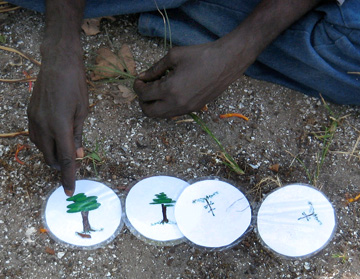Speaking About the Way We Speak
Does the language we speak influence the way we think? Alice Gaby, a professor of linguistics at Berkeley, became particularly interested in this question about five years ago as she studied an Aborignal language called Kuuk Thayorre.
This is the language spoken by the residents of a former mission community on the Cape York Peninsula of northeastern Australia. Kuuk Thayorre speakers live in a small coastal community called Pormpuraaw. Residents grew up living a traditional lifestyle until the mission was established in 1938.

Working with Stanford University psychologist Lera Boroditsky, Gaby launched a study of the ways that languages make links between time and space. They set out to compare languages where speakers use left and right, or similar body-centered words, with languages that primarily use words for north, south, east, and west.
Speakers of the most studied languages - which include English, Hebrew, Chinese, German and the Romance languages - talk about time and space in the same way, referring to left and right and using their own bodies as the reference point. "There is a lot of research that claims it is universal to draw on the vocabulary of space to talk about time," Gaby says. Speakers of English, for example, talk about moving a meeting "forward" or "back" in time.
Looking at Kuuk Thayorre, however, Gaby realized this universalist hypothesis was not correct. "In Kuuk Thayorre there are no extended spatial metaphors to talk about time. This is unusual." Speakers of Kuuk Thayorre, for example, speak about directionality in terms of north, south, east and west rather than using temporal metaphors.
If the Kuuk Thayorre language does not use words like "before" and "ahead" to talk about time, Gaby went on to ask, what does that mean about the way they look at the world?
Perception about space, geography and time reveals a lot about human cultures. In many indigenous languages of Australia, for example, speakers describe the location of places and objects in terms of their relationship to cardinal directions and watercourses. A campsite may be "up-river" from a hunting area. A person may be instructed to pull a door "northwards" in order to open it.
"This kind of linguistic system reflects an adaptive way of thinking when there are no directive road signs," Gaby says. "It is important to stay oriented in an unfamiliar place. In that situation, remembering left and right won't really help you."
Gaby and her Stanford collaborator worked with English-speaking subjects in Palo Alto and Kuuk Thayorre speakers in Australia. They designed cards that showed temporal sequences, like a chick hatching from an egg or an infant growing into an adult. All test subjects were seated facing the same direction and were asked to arrange the cards in the correct order. Then the subjects were asked to face a different direction and again arrange the cards in the correct order.
English speakers arranged the cards according to their own point of view, from left to right, while Kuuk Thayorre speakers arranged the cards using an east-west orientation, so that they would look the same as the first arrangement if viewed from above.
"This result shows a very different response than anything we'd seen before and challenges the assumption that the language of time and space are universally linked," Gaby says. While the Kuuk Thayorre speakers were clearly using their direction language in their way of thinking about space, this isn't reflected in the way they talk about time.
"There is no metaphor for ‘four years East' in the way one might say, ‘four years back or before,'" she says. "Although there is a relationship between the language of space, on the one hand, and thought about space and time, on the other, the link is not nearly as direct or simple as we have assumed."
